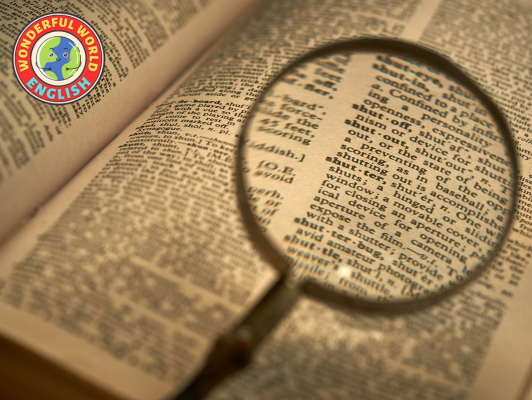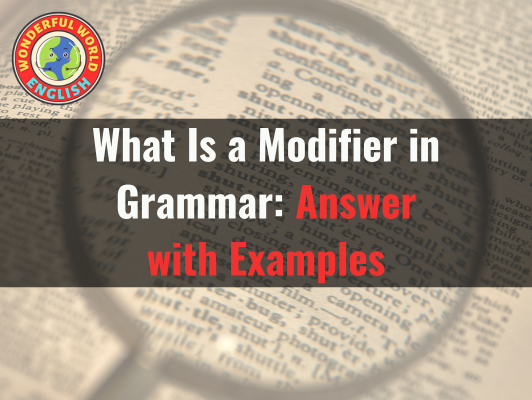Contents
Toggle
Meet David De’ Ath, founder, editor, and writer at Wonderful World English. With his extensive background as an English teacher, David provides valuable insights and practical tips on ESL for students and teachers alike.
A modifier in grammar is an essential tool that enhances and specifies a word’s meaning.
They’re typically adjectives and adverbs but can also be phrases or clauses, functioning to describe, qualify, or limit the words they modify.
These linguistic components are fundamental in providing detail and depth to sentences, allowing speakers and writers to convey precise shades of meaning.
Modifiers in English grammar, such as adjectives and adverbs, add detail and clarity to sentences. They must be correctly placed to avoid confusion. These elements, including phrases and clauses, enrich communication by specifying and enhancing the meanings of words, making language more precise and expressive.
Without modifiers, language would be less colorful and more ambiguous, with many statements lacking the clarity that modifiers provide.
Understanding how to use modifiers correctly is key to mastering the English language.
Misplacing a modifier can often lead to confusion or unintended humor.
Hence, the proper placement of a modifier is paramount.
It should be located as close as possible to the word it modifies to ensure the sentence’s meaning is clear and straightforward.
This precision helps avoid ambiguity and enhances communication by making the intent and imagery behind the writer’s words more vivid.
Key Takeaways
- Modifiers enrich language by providing additional detail.
- Correct placement of modifiers is crucial for clear communication.
- Modifiers can take the form of words, phrases, or clauses.

Understanding Modifiers
Modifiers play a crucial role in enriching language by providing additional information about various elements within a sentence.
They refine meaning and bring clarity to text, allowing for more detailed descriptions and specificity.
Defining Modifier Types
Modifiers in English grammar can be classified into adjectives and adverbs.
Adjectives modify nouns and pronouns, adding detail or limiting their meaning.
On the other hand, adverbs primarily modify verbs, but they can also modify adjectives, other adverbs, and even whole sentences.
These modifications can take the form of single words, such as “quickly” or “blue,” as well as multi-word phrases and clauses like “running water” (participle phrase) or “which was blue” (relative clause).
Roles and Functions
Modifiers serve various roles in sentences: descriptive modifiers give detailed characteristics, while limiting modifiers, including possessive determiners, quantifiers, and articles, restrict a term’s reference.
For example, “the loud dog” uses a descriptive adjective “loud” and a limiting article “the.” Intensifiers and qualifiers express degrees of quality or quantity, such as “very” or “somewhat.”
Position in Sentences
The placement of a modifier is vital for clarity.
A premodifier is placed before the head of the noun phrase or verb phrase it is modifying, such as “beautiful” in “beautiful painting.”
In contrast, a postmodifier follows the word it modifies, like “that sings” in “the bird that sings.”
In adjectival and adverbial phrases or prepositional phrases, word order can critically determine the intended meaning.
Common Errors
Misplaced modifiers are incorrectly positioned so that they appear to modify the wrong word, causing confusion while dangling modifiers lack a clear subject entirely.
For example, “hungry” in “the sandwich was eaten by the boy who was very hungry” is a misplaced modifier because it incorrectly suggests the sandwich was hungry.
A squinting modifier is ambiguously placed, often between two potential referents, such as “often” in “students who study often get good grades.”
Correctly using modifiers is essential for clear and accurate communication in English grammar. Understanding how to apply them effectively can greatly enhance language’s precision and fluidity.
Related: Easy Grammar Tricks: Ultimate Guide for Students
| Type of Modifier | Example | Function | Placement in Sentence |
|---|---|---|---|
| Adjective | The quiet room | Describes the noun ‘room’ | Before the noun |
| Adverb | She spoke softly | Modifies the verb ‘spoke’ to describe how the action is performed | After the verb |
| Phrase | The cat on the mat | Provides additional information about the noun ‘cat’ | After the noun |
| Clause | The man who was tall stood up | Gives extra detail about ‘the man’ | After the noun |
| Demonstrative | This apple | Specifies which apple is being referred to | Before the noun |
| Infinitive | To run faster | Indicates purpose or intent | Can vary depending on its role in the sentence |
| Quantifier | Several books | Indicates the amount or quantity of the noun ‘books’ | Before the noun |
Application and Examples
In understanding the application of modifiers, it is crucial to recognize their role in providing additional detail and clarity to a sentence.
Modifiers can be words, phrases, or clauses, and they serve to qualify or change the meaning of a noun or verb, thereby enhancing the descriptiveness of language.
Modifier Usage in English
Modifiers in English grammar come in various forms and are used to add detail or clarification.
Adjectives and adverbs are the most common types of modifiers.
Adjectives modify nouns by providing more information about the nouns’ attributes.
In contrast, adverbs primarily modify verbs, adjectives, or other adverbs, often indicating the manner, degree, frequency, or time of the action being described.
Illustrative examples of adjective modifiers:
- The colorful balloons floated away.
- She adopted an energetic puppy.
Illustrative examples of adverb modifiers:
- He drove incredibly fast.
- She sang the song remarkably well.
In English syntax, modifiers can appear before or after the word they modify.
Demonstrative modifiers are a specific type of modifier that points out a specific noun, as in “this book” or “that idea.”
Modifiers can also appear in the form of infinitives (to + verb) or quantifiers, which provide information regarding the number or amount.
Modifiers need to be placed close to the words they modify to avoid confusion or misplaced modifiers.
For example, “She only reviewed the document quickly” implies that reviewing was the only action taken quickly, whereas “She reviewed the document only quickly” might suggest that the document was only skimmed, not read in detail.
Comparing Languages
When examining modifiers across languages, one can see differences in their use and importance.
For instance, in French, adjectives can be placed before or after the noun they modify and often agree in gender and number with the noun, unlike in English.
- In English: The young girls
- In French: Les filles jeunes (jeunes comes after the noun and agrees in gender and number)
Additionally, in French, certain adjectives change meaning based on their placement before or after the noun, which is not a characteristic of English grammar.
While English relies on a more fixed word order due to its syntactical structure, some languages utilize modifiers to dictate relationships between words within a sentence.
This linguistic feature reflects different ways that languages can approach the concept of providing detailed information and exemplifies modifiers’ various roles in communication.
Check out the link below for our top picks of apps to learn English grammar!
Related: Best Apps for Learning English Grammar – Top 10

Conclusion
In grammar, modifiers are vital for enriching language, providing specificity, and adding clarity to our expressions.
They come in various forms, including adjectives, adverbs, phrases, and clauses, each serving to modify and add detail to the words they accompany.
These elements allow for nuanced communication, enabling speakers and writers to convey precise meanings and vivid descriptions.
The correct placement of modifiers is crucial; misplaced or dangling modifiers can lead to confusion or unintended meanings.
Understanding and effectively employing modifiers is fundamental to mastering English, enhancing the language’s descriptiveness and clarity, and ensuring that communication is accurate and expressive.
We hope you find value in this information, and feel free to contact us if you require any assistance.
Have a wonderful day!
Image Attribution: All images licensed via canva.com






